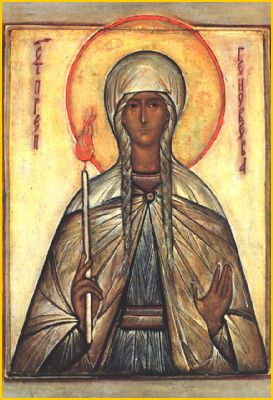|
|||
|---|---|---|---|
| This weekly bulletin insert complements the curriculum published by the Department of Christian Education of the Orthodox Church in America. This and many other Christian Education resources are available at http://dce.oca.org. | |||

Saint Genevieve of Paris lived during the mid-fifth century. This was the very time when Attila the Hun was threatening to conquer France. In his years of power, Attila built an empire stretching from Russia to the Rhine River, and from the Danube River to the Baltic Sea. So when he brought his soldiers thundering into France with the intention of taking Paris, many inhabitants were in an understandable state of panic and ready to flee. One resident, however, had a different idea, and that was Genevieve. She was from a family of peasants in Nanterre, and knew from childhood that she wanted to be a nun. She entered monastic life at the age of fifteen. When her parents died she had come to live with her godmother in Paris, and became well-known for her charity and prayerfulness. She kept a strict vegetarian diet and didn't allow herself any extra physical comforts such as a soft bed or lotions to smooth her skin. The pleasures of the world didn't appeal to her, and her trust in God made her courageous and able to face anything. So when word of Attila's approach spread through the city, Genevieve didn't even think of running away. Instead, she stood at the city walls and urged people to pray, leading them in the effort for hours. At first, some city leaders were furious with her for exposing the people to terrible danger by urging them to stay. But in the end, Attila turned back from Paris and took his armies in another direction. This wonderful event, in the year 451, was the inspiration for Saint Genevieve being seen as the protectress of the city. But this wasn't the only time Genevieve would play a role in saving the people of Paris. In the year 464, the city was attacked by Childeric, a Frankish king. He set up a siege and blockaded the ports, threatening the city with starvation. Genevieve was able to arrange for a boat to get through, bringing grain to the city so that the people could have bread. For this reason, some icons show her holding a loaf of bread. Other icons show Saint Genevieve with a lighted candle—a reminder of another miraculous event in her life. One windy night, she and her nuns were on their way to church, going along muddy paths in the dark. Suddenly, a strong gust of wind blew out the candles they were carrying. The nuns were ready to turn back to the monastery—but not Abbess Genevieve. She was determined to get them all to church, and prayed for God's help. As she did so, the candles came alight again, and did not go out even though the nuns could still feel the strong wind. They were able to get safely to church and home again. Perhaps even more important, they saw again their abbess' trust in God, which could overcome strong wind and fierce warriors. |
|||
